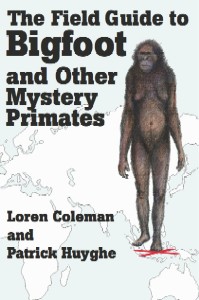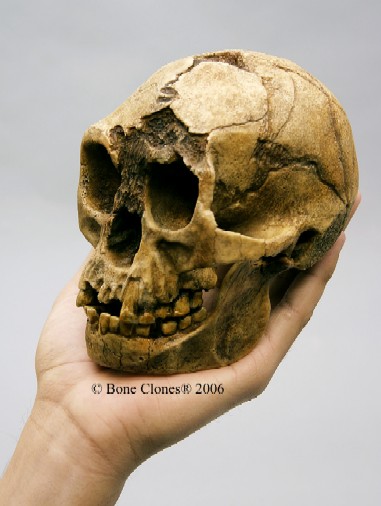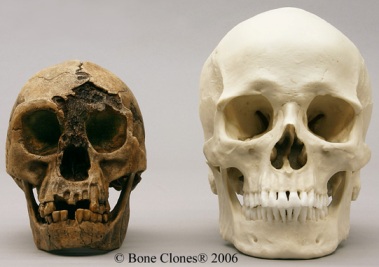
January 27, 2007

What’s wrong with this drawing? (The answer is below.)
Homo floresiensis, the “Hobbits” of Indonesia have been in the news again lately.
This week it was announced that the dig will start up anew at the same cave where all the previous discoveries have been made on Flores.
First, a flashback: How important and significant is the discovery of this species to cryptozoology? The editor of Nature, Henry Gee, in a 2004 editorial entitled “Flores, God and Cryptozoology,” wrote:
The discovery that Homo floresiensis survived until so very recently, in geological terms, makes it more likely that stories of other mythical, human-like creatures such as Yetis are founded on grains of truth….Now, cryptozoology, the study of such fabulous creatures, can come in from the cold.Henry Gee
Now the discoverers are going back to look for more, after being blocked from doing so.
Professor Richard “Bert” Roberts, from the University of Wollongong in Australia, a member of the team that found the specimens, told BBC News:
This year we will back in Liang Bua again, back in the cave where we found the Hobbits. This is good; we’ve now managed to get over the political hurdles that had been put up. We’ll probably be in there towards the middle of the year.
It’s now a matter of getting everything organized so we can start digging again. You’ve got to get there in the dry season; in the wet season you can hardly drive to the site and when you are there, there are puddles of water all over the floor – so it’s got to be dry to sensibly dig holes.Professor Richard “Bert” Roberts
Mike Morwood, director of the excavation, also told BBC News the remains at Liang Bua could be the tip of the iceberg:
South-East Asia and East Asia are going to yield an awful lot of surprises and it’s going to make a major contribution to our understanding of hominin evolution.
This particular discovery seems to have prompted people to rethink what it is to be human, the relationship between brain size and behaviour, and whether hominin populations have been insulated from environmental factors. This indicates that they haven’t.
It also raises questions about the colonisation capabilities of early hominids. What are they doing on Flores and what are they almost certainly doing on other islands in South-East Asia.Mike Morwood
As I wrote in 2004, one way to investigate further future sites to look for evidence of Homo floresiensis is to search out and listen to the stories about little people. But that time is not coming soon, as it is back to Liang Bua first, for now.
When discussing the announced discovery of Homo floresiensis as one of the top stories of 2004, I wrote:
Local natives on Flores have one hundred year old legends of a small hairy people, the Ebu Gogo, and clues from these tales will be employed to find new caves to explore for evidence of their former little habitants. While Sumatra’s Orang Pendek has been mentioned in the same context as the media nicknamed ‘Hobbits’ of Flores, the more relevant cryptids are not anthropoids, but the fully manlike ones, such as the Nittaewo, the three feet tall hairy hominids of ancient Ceylon (Sri Lanka) — mentioned by Pliny in the first century — who were said to exist to the end of the 18th Century. It is time to look again at reports of little people, with an eye to the discovery of their subfossil remains and living existence, from Sri Lanka to the South Pacific.Loren Coleman
National Geographic’s representation (at top) of Homo floresiensis, a “Hobbit” is incorrect. Why? Well, for starters, the first type specimen is not shown well above because LB1 was not a male specimen. They also may have been hairier. Richard Klyver’s drawing (below) of a female H. floresiensis may be much closer to how she appeared.

This interpretation of the Flores woman, Homo floresiensis, by wildlife artist Richard Klyver, is based on the Australian and Indonesian discovery combined with my cryptozoology research on recent evidence, such as the sightings and folklore of Asia’s unknown hominoids. The drawing of the LB1 female is shown standing on a map with a red X marking Flores, from the cover of The Field Guide to Bigfoot and Other Mystery Primates by Loren Coleman and Patrick Huyghe.

Even you can own an important part of cryptozoological and anthropological history, the Bone Clones’ Homo floresiensis skull replica.

Orders for the Bone Clones reproduction can be made by going to the Bone Clones ordering information here.
About Loren Coleman
Loren Coleman is one of the world’s leading cryptozoologists, some say “the” leading living cryptozoologist. Certainly, he is acknowledged as the current living American researcher and writer who has most popularized cryptozoology in the late 20th and early 21st centuries.
Starting his fieldwork and investigations in 1960, after traveling and trekking extensively in pursuit of cryptozoological mysteries, Coleman began writing to share his experiences in 1969. An honorary member of Ivan T. Sanderson’s Society for the Investigation of the Unexplained in the 1970s, Coleman has been bestowed with similar honorary memberships of the North Idaho College Cryptozoology Club in 1983, and in subsequent years, that of the British Columbia Scientific Cryptozoology Club, CryptoSafari International, and other international organizations. He was also a Life Member and Benefactor of the International Society of Cryptozoology (now-defunct).
Loren Coleman’s daily blog, as a member of the Cryptomundo Team, served as an ongoing avenue of communication for the ever-growing body of cryptozoo news from 2005 through 2013. He returned as an infrequent contributor beginning Halloween week of 2015.
Coleman is the founder in 2003, and current director of the International Cryptozoology Museum in Portland, Maine.
Filed under Artifacts, Breaking News, CryptoZoo News, Cryptozoologists, Cryptozoology, Folklore, Homo floresiensis